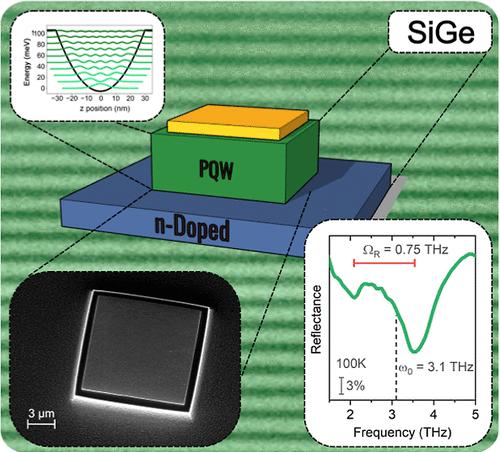当前位置:
X-MOL 学术
›
ACS Photonics
›
论文详情
Our official English website, www.x-mol.net, welcomes your feedback! (Note: you will need to create a separate account there.)
Ultrastrong Coupling of Si1–xGex Parabolic Quantum Wells to Terahertz Microcavities
ACS Photonics ( IF 6.5 ) Pub Date : 2024-06-21 , DOI: 10.1021/acsphotonics.4c00641 Fritz Berkmann 1 , Tommaso Venanzi 1 , Leonetta Baldassarre 1 , Elena Campagna 2 , Enrico Talamas Simola 2 , Luciana Di Gaspare 2 , Cedric Corley-Wiciak 3, 4 , Giovanni Capellini 2, 3 , Giuseppe Nicotra 5 , Gianfranco Sfuncia 5 , Andrea Notargiacomo 6 , Ennio Giovine 6 , Sara Cibella 6 , Michele Virgilio 7 , Giacomo Scalari 8 , Monica De Seta 2 , Michele Ortolani 1
ACS Photonics ( IF 6.5 ) Pub Date : 2024-06-21 , DOI: 10.1021/acsphotonics.4c00641 Fritz Berkmann 1 , Tommaso Venanzi 1 , Leonetta Baldassarre 1 , Elena Campagna 2 , Enrico Talamas Simola 2 , Luciana Di Gaspare 2 , Cedric Corley-Wiciak 3, 4 , Giovanni Capellini 2, 3 , Giuseppe Nicotra 5 , Gianfranco Sfuncia 5 , Andrea Notargiacomo 6 , Ennio Giovine 6 , Sara Cibella 6 , Michele Virgilio 7 , Giacomo Scalari 8 , Monica De Seta 2 , Michele Ortolani 1
Affiliation

|
Control and manipulation of quantum states by light are increasingly important for both fundamental research and applications. This can be achieved through the strong coupling between light and semiconductor devices, typically observed at THz frequencies in 2D electron gases embedded in lithographic optical cavities. Here, we explore the possibility of achieving ultrastrong coupling between conduction sub-band states in Si1–xGex heterostructures and THz cavity photons fabricated with a potentially silicon-CMOS-compliant process. We developed Si1–xGex parabolic quantum wells with a transition at ω0 = 3.1 THz and hybrid metal-plasmonic THz patch-antenna microcavities resonating between 2 and 5 THz depending on the antenna length. In this first demonstration, we achieved anticrossing around 3 THz with spectroscopically measured Rabi frequency ΩR ≃ 0.7 THz (ΩR/ω0 ≃ 0.2, i.e., ultrastrong coupling). The present group-IV semiconductor material platform can be extended to the 5–12 THz range, where these semiconductors are transparent, as opposed to the III–V compound semiconductors plagued by strong THz optical phonon absorption. Moreover, the intersubband transition in parabolic quantum wells hosted by the nonpolar Si1–xGex crystal lattice is robust against carrier density and temperature variations, making the strength of the coupling only weakly temperature-dependent from 10 to 300 K. These results pave the way for the employment of the Si1–xGex material platform to perform fundamental research in ultrastrong light–matter coupling, fully exploiting the plasmonic character of the cavity mirror, as well as in ultrafast modulators and saturable absorbers for THz laser research.
中文翻译:

Si1–xGex 抛物线量子阱与太赫兹微腔的超强耦合
光对量子态的控制和操纵对于基础研究和应用来说越来越重要。这可以通过光和半导体器件之间的强耦合来实现,通常在嵌入光刻光学腔中的二维电子气中的太赫兹频率下观察到。在这里,我们探索了在 Si 1–x Ge x 异质结构中的传导子带态与采用潜在的硅 CMOS 兼容工艺制造的太赫兹腔光子之间实现超强耦合的可能性。我们开发了在 ω 0 = 3.1 THz 处跃迁的 Si 1–x Ge x 抛物线量子阱以及在 2 和 2 之间谐振的混合金属等离子体太赫兹贴片天线微腔。 5 THz,取决于天线长度。在第一个演示中,我们在 3 THz 左右实现了反交叉,光谱测量的拉比频率 Ω R ≃ 0.7 THz (Ω R /ω 0 ≃ 0.2,即超强耦合)。目前的 IV 族半导体材料平台可以扩展到 5-12 THz 范围,这些半导体是透明的,而不是受到强太赫兹光学声子吸收困扰的 III-V 族化合物半导体。此外,非极性 Si 1–x Ge x 晶格所承载的抛物线量子阱中的子带间跃迁对于载流子密度和温度变化具有鲁棒性,使得耦合强度仅对温度有微弱影响。依赖于 10 至 300 K。 这些结果为利用Si 1–x Ge x 材料平台进行超强光-物质耦合的基础研究铺平了道路,充分利用腔镜的等离子体特性,以及用于太赫兹激光研究的超快调制器和可饱和吸收器。
更新日期:2024-06-21
中文翻译:

Si1–xGex 抛物线量子阱与太赫兹微腔的超强耦合
光对量子态的控制和操纵对于基础研究和应用来说越来越重要。这可以通过光和半导体器件之间的强耦合来实现,通常在嵌入光刻光学腔中的二维电子气中的太赫兹频率下观察到。在这里,我们探索了在 Si 1–x Ge x 异质结构中的传导子带态与采用潜在的硅 CMOS 兼容工艺制造的太赫兹腔光子之间实现超强耦合的可能性。我们开发了在 ω 0 = 3.1 THz 处跃迁的 Si 1–x Ge x 抛物线量子阱以及在 2 和 2 之间谐振的混合金属等离子体太赫兹贴片天线微腔。 5 THz,取决于天线长度。在第一个演示中,我们在 3 THz 左右实现了反交叉,光谱测量的拉比频率 Ω R ≃ 0.7 THz (Ω R /ω 0 ≃ 0.2,即超强耦合)。目前的 IV 族半导体材料平台可以扩展到 5-12 THz 范围,这些半导体是透明的,而不是受到强太赫兹光学声子吸收困扰的 III-V 族化合物半导体。此外,非极性 Si 1–x Ge x 晶格所承载的抛物线量子阱中的子带间跃迁对于载流子密度和温度变化具有鲁棒性,使得耦合强度仅对温度有微弱影响。依赖于 10 至 300 K。 这些结果为利用Si 1–x Ge x 材料平台进行超强光-物质耦合的基础研究铺平了道路,充分利用腔镜的等离子体特性,以及用于太赫兹激光研究的超快调制器和可饱和吸收器。






































 京公网安备 11010802027423号
京公网安备 11010802027423号